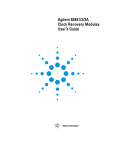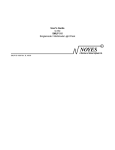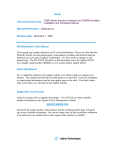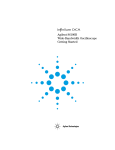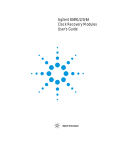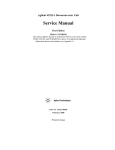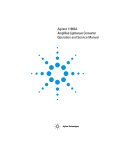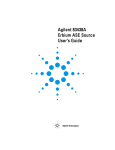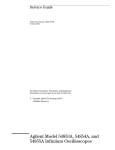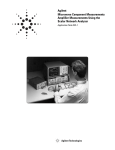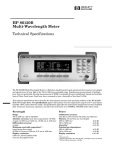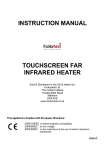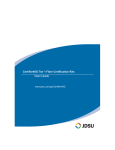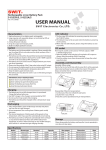Download Spec flie
Transcript
Agilent 11980A Fiber Optic Interferometer Operation and Service Manual © Copyright Agilent Technologies 2000 All Rights Reserved. Reproduction, adaptation, or translation without prior written permission is prohibited, except as allowed under copyright laws. Agilent Part No. 11980-90012 Printed in USA April 2000 Agilent Technologies Lightwave Division 1400 Fountaingrove Parkway Santa Rosa, CA 95403-1799, USA (707) 577-1400 Notice. The information contained in this document is subject to change without notice. Companies, names, and data used in examples herein are fictitious unless otherwise noted. Agilent Technologies makes no warranty of any kind with regard to this material, including but not limited to, the implied warranties of merchantability and fitness for a particular purpose. Agilent Technologies shall not be liable for errors contained herein or for incidental or consequential damages in connection with the furnishing, performance, or use of this material. Restricted Rights Legend. Use, duplication, or disclosure by the U.S. Government is subject to restrictions as set forth in subparagraph (c) (1) (ii) of the Rights in Technical Data and Computer Software clause at DFARS 252.227-7013 for DOD agencies, and subparagraphs (c) (1) and (c) (2) of the Commercial Computer Software Restricted Rights clause at FAR 52.227-19 for other agencies. Warranty. This Agilent Technologies instrument product is warranted against defects in material and workmanship for a period of one year from date of shipment. During the warranty period, Agilent Technologies will, at its option, either repair or replace products which prove to be defective. For warranty service or repair, this product must be returned to a service facility designated by Agilent Technologies. Buyer shall prepay shipping charges to Agilent Technologies and Agilent Technologies shall pay shipping charges to return the product to Buyer. However, Buyer shall pay all shipping charges, duties, and taxes for products returned to Agilent Technologies from another country. Agilent Technologies warrants that its software and firmware designated by Agilent Technologies for use with an instrument will execute its programming instructions when properly installed on that instrument. Agilent Technologies does not warrant that the operation of the instrument, or software, or firmware will be uninterrupted or errorfree. Limitation of Warranty. The foregoing warranty shall not apply to defects resulting from improper or inadequate maintenance by Buyer, Buyersupplied software or interfacing, unauthorized modification or misuse, operation outside of the environmental specifications for the product, or improper site preparation or maintenance. No other warranty is expressed or implied. Agilent Technologies specifically disclaims the implied warranties of merchantability and fitness for a particular purpose. Exclusive Remedies. The remedies provided herein are buyer's sole and exclusive remedies. Agilent Technolo- ii ❍ The OFF symbols are used to mark the positions of the instrument power line switch. gies shall not be liable for any direct, indirect, special, incidental, or consequential damages, whether based on contract, tort, or any other legal theory. The CE mark is a registered trademark of the European Community. Safety Symbols. CAUTION The caution sign denotes a hazard. It calls attention to a procedure which, if not correctly performed or adhered to, could result in damage to or destruction of the product. Do not proceed beyond a caution sign until the indicated conditions are fully understood and met. The CSA mark is a registered trademark of the Canadian Standards Association. The C-Tick mark is a registered trademark of the Australian Spectrum Management Agency. WARNING The warning sign denotes a hazard. It calls attention to a procedure which, if not correctly performed or adhered to, could result in injury or loss of life. Do not proceed beyond a warning sign until the indicated conditions are fully understood and met. The instruction manual symbol. The product is marked with this warning symbol when it is necessary for the user to refer to the instructions in the manual. The laser radiation symbol. This warning symbol is marked on products which have a laser output. The AC symbol is used to indicate the required nature of the line module input power. | The ON symbols are used to mark the positions of the instrument power line switch. ISM1-A This text denotes the instrument is an Industrial Scientific and Medical Group 1 Class A product. Typographical Conventions. The following conventions are used in this book: Key type for keys or text located on the keyboard or instrument. Softkey type for key names that are displayed on the instrument’s screen. Display type for words or characters displayed on the computer’s screen or instrument’s display. User type for words or charac- ters that you type or enter. Emphasis type for words or characters that emphasize some point or that are used as place holders for text that you type. General Safety Considerations General Safety Considerations This product has been designed and tested in accordance with IEC Publication 61010-1, Safety Requirements for Electrical Equipment for Measurement, Control and Laboratory Use, and has been supplied in a safe condition. The instruction documentation contains information and warnings that must be followed by the user to ensure safe operation and to maintain the product in a safe condition. WARNING If this instrument is not used as specified, the protection provided by the equipment could be impaired. This instrument must be used in a normal condition (in which all means for protection are intact) only. WARNING No operator serviceable parts inside. Refer servicing to qualified personnel. To prevent electrical shock, do not remove covers. WARNING To prevent electrical shock, disconnect the Agilent 11980A from mains before cleaning. Use a dry cloth or one slightly dampened with water to clean the external case parts. Do not attempt to clean internally. WARNING This is a Safety Class 1 product (provided with a protective earthing ground incorporated in the power cord). The mains plug shall only be inserted in a socket outlet provided with a protective earth contact. Any interruption of the protective conductor inside or outside of the product is likely to make the product dangerous. Intentional interruption is prohibited. WARNING For continued protection against fire hazard, replace line fuse only with same type and ratings, (type T 0.315A/250V for 100/120V operation and 0.16A/250V for 220/240V operation). The use of other fuses or materials is prohibited. Verify that the value of the linevoltage fuse is correct. • For 100/120V operation, use an IEC 127 5×20 mm, 0.315 A, 250 V, Agilent part number 2110-0449. • For 220/240V operation, use an IEC 127 5×20 mm, 0.16 A, 250 V, Agilent Technologies part number 2110-0448. iii General Safety Considerations CAUTION Before switching on this instrument, make sure that the line voltage selector switch is set to the line voltage of the power supply and the correct fuse is installed. Assure the supply voltage is in the specified range. CAUTION This product is designed for use in Installation Category II and Pollution Degree 2 per IEC 1010 and 664 respectively. CAUTION VENTILATION REQUIREMENTS: When installing the product in a cabinet, the convection into and out of the product must not be restricted. The ambient temperature (outside the cabinet) must be less than the maximum operating temperature of the product by 4°C for every 100 watts dissipated in the cabinet. If the total power dissipated in the cabinet is greater than 800 watts, then forced convection must be used. CAUTION Always use the three-prong ac power cord supplied with this instrument. Failure to ensure adequate earth grounding by not using this cord may cause instrument damage. CAUTION Do not connect ac power until you have verified the line voltage is correct. Damage to the equipment could result. CAUTION This instrument has autoranging line voltage input. Be sure the supply voltage is within the specified range. Measurement accuracy—it’s up to you! Fiber-optic connectors are easily damaged when connected to dirty or damaged cables and accessories. The Agilent 11980A front-panel OPTICAL OUT connector is no exception. When you use improper cleaning and handling techniques, you risk expensive instrument repairs, damaged cables, and compromised measurements. Before you connect any fiber-optic cable to the Agilent 11980A, refer to “Cleaning Connections for Accurate Measurements” on page 3-3. iv Contents 1 General Information Description 1-2 Options 1-3 Initial Inspection 1-4 Returning the Instrument for Service 1-5 Preparing the instrument for shipping 1-5 Agilent Technologies Service Offices 1-8 2 Specifications Specifications 2-2 3 User Precautions Front-Panel Knob 3-2 Connector Care 3-2 Cleaning Connections for Accurate Measurements 3-3 Choosing the Right Connector 3-3 Inspecting Connectors 3-6 Cleaning Connectors 3-10 4 Operation Theory of Operation 4-2 Applications 4-3 Static Linewidth Measurement 4-3 Chirp and FM Measurements 4-5 5 Operation Verification Operation Verification 5-2 Optical Insertion Loss Test 5-3 Interferometric Test 5-5 6 Replaceable Parts Replaceable Parts 6-2 Contents-1 1 Description 1-2 Options 1-3 Initial Inspection 1-4 Returning the Instrument for Service 1-5 Agilent Technologies Service Offices 1-8 General Information General Information Description Description The Agilent 11980A fiber optic interferometer is a Mach Zehnder interferometer built with a fixed length of single-mode optical fiber. The Agilent 11980A splits the optical energy into two paths, delaying one path with respect to the other, and recombines them in a second optical coupler. A polarization adjustment helps align the optical fields for maximum interference, as shown in Figure 1-1. The Agilent 11980A is a lightwave accessory for use with the Agilent 71400C, 71401C, and 83810A lightwave signal analyzers. The Agilent 11980A allows you to measure linewidth, chirp, and FM characteristics of single-line lasers. Figure 1-1. Agilent 11980A Fiber Optic Interferometer, Simplified Schematic 1-2 General Information Options Options Several options are available when ordering the Agilent 11980A. • Option 005 lengthens the delay line from 760 meters to 5.2 kilometers, allowing measurement of narrower linewidths. • Options 011 through 015 allow you to order your choice of several optical connector interfaces. This makes it simple to interface to your connector standard. Table 1-1 lists the available connector interface families. Table 1-1. Agilent 11980A Connector Options Option Agilent Part Numbera Interface Standard 011 81000AI HMS-10 012 81000FI FC/PC 013 81000SI DIN 47256 014 81000VI ST 015 81000WI Biconic a. Includes dust cap. 1-3 General Information Initial Inspection Initial Inspection If the shipment contents are incomplete or damaged, refer to “Returning the Instrument for Service” on page 1-5. If the shipping container is damaged, or the cushioning material shows signs of stress, notify the carrier as well as the Agilent Technologies office. Refer to “Agilent Technologies Service Offices” on page 1-8. Keep the shipping materials for the carrier’s inspection. Agilent Technologies will arrange for repair or replacement without waiting for a claim settlement. 1-4 General Information Returning the Instrument for Service Returning the Instrument for Service The instructions in this section show you how to properly return the instrument for repair or calibration. Always call the Agilent Technologies Instrument Support Center first to initiate service before returning your instrument to a service office. This ensures that the repair (or calibration) can be properly tracked and that your instrument will be returned to you as quickly as possible. Call this number regardless of where you are located. Refer to “Agilent Technologies Service Offices” on page 1-8 for a list of service offices. Agilent Technologies Instrument Support Center. . . . . . . . . . . (800) 403-0801 If the instrument is still under warranty or is covered by an Agilent Technologies maintenance contract, it will be repaired under the terms of the warranty or contract (the warranty is at the front of this manual). If the instrument is no longer under warranty or is not covered by an Agilent Technologies maintenance plan, Agilent Technologies will notify you of the cost of the repair after examining the unit. When an instrument is returned to a Agilent Technologies service office for servicing, it must be adequately packaged and have a complete description of the failure symptoms attached. When describing the failure, please be as specific as possible about the nature of the problem. Include copies of additional failure information (such as the instrument failure settings, data related to instrument failure, and error messages) along with the instrument being returned. Preparing the instrument for shipping 1 Write a complete description of the failure and attach it to the instrument. Include any specific performance details related to the problem. The following 1-5 General Information Returning the Instrument for Service information should be returned with the instrument. • Type of service required. • Date instrument was returned for repair. • Description of the problem: • Whether problem is constant or intermittent. • Whether instrument is temperature-sensitive. • Whether instrument is vibration-sensitive. • Instrument settings required to reproduce the problem. • Performance data. • Company name and return address. • Name and phone number of technical contact person. • Model number of returned instrument. • Full serial number of returned instrument. • List of any accessories returned with instrument. 2 Cover all front or rear-panel connectors that were originally covered when you first received the instrument. CAUTION Cover electrical connectors to protect sensitive components from electrostatic damage. Cover optical connectors to protect them from damage due to physical contact or dust. CAUTION Instrument damage can result from using packaging materials other than the original materials. Never use styrene pellets as packaging material. They do not adequately cushion the instrument or prevent it from shifting in the carton. They may also cause instrument damage by generating static electricity. 3 Pack the instrument in the original shipping containers. Original materials are available through any Agilent Technologies office. Or, use the following guidelines: • Wrap the instrument in antistatic plastic to reduce the possibility of damage caused by electrostatic discharge. • For instruments weighing less than 54 kg (120 lb), use a double-walled, corrugated cardboard carton of 159 kg (350 lb) test strength. • The carton must be large enough to allow approximately 7 cm (3 inches) on all sides of the instrument for packing material, and strong enough to accommodate the weight of the instrument. • Surround the equipment with approximately 7 cm (3 inches) of packing material, to protect the instrument and prevent it from moving in the carton. If packing foam is not available, the best alternative is S.D-240 Air Cap™ from 1-6 General Information Returning the Instrument for Service Sealed Air Corporation (Commerce, California 90001). Air Cap looks like a plastic sheet filled with air bubbles. Use the pink (antistatic) Air Cap™ to reduce static electricity. Wrapping the instrument several times in this material will protect the instrument and prevent it from moving in the carton. 4 Seal the carton with strong nylon adhesive tape. 5 Mark the carton “FRAGILE, HANDLE WITH CARE”. 6 Retain copies of all shipping papers. 1-7 General Information Agilent Technologies Service Offices Agilent Technologies Service Offices Before returning an instrument for service, call the Agilent Technologies Instrument Support Center at (800) 403-0801, visit the Test and Measurement Web Sites by Country page at http://www.tm.agilent.com/tmo/country/English/ index.html, or call one of the numbers listed below. Agilent Technologies Service Numbers Austria 01/25125-7171 Belgium 32-2-778.37.71 Brazil (11) 7297-8600 China 86 10 6261 3819 Denmark 45 99 12 88 Finland 358-10-855-2360 France 01.69.82.66.66 Germany 0180/524-6330 India 080-34 35788 Italy +39 02 9212 2701 Ireland 01 615 8222 Japan (81)-426-56-7832 Korea 82/2-3770-0419 Mexico (5) 258-4826 Netherlands 020-547 6463 Norway 22 73 57 59 Russia +7-095-797-3930 Spain (34/91) 631 1213 Sweden 08-5064 8700 Switzerland (01) 735 7200 United Kingdom 01 344 366666 United States and Canada (800) 403-0801 1-8 2 Specifications Specifications Specifications Specifications Table 2-1 lists specifications for the Agilent 11980A. An asterisk (*) placed after an entry indicates that it is a supplemental characteristic. Characteristics are not specifications; they are included as additional information for the user. Table 2-1. Agilent 11980A Specifications Optical Insertion Loss < 8 dB at 1320 nm < 8 dB at 1550 nm Wavelength Range* 1250 nm to 1600 nm Delay Time* 3.5 µs Delay Time, Option 005* 25 µs Connectors Single-mode optical Maximum Input Power as limited by lightwave analyzer* 250 mW Temperature Range Operating: 0°C to 55°C Storage: –40°C to 75°Ca Weight* Net: 1.9 kg (4.2 lb) Shipping: 3.2 kg (7 lb) Weight, Option 005* Net: 2.3 kg (5 lb) Shipping: 3.5 kg (7.8 lb) Maximum Dimensions 105 mm H × 215 mm W × 290 mm L (4.1 in H × 8.5 in W × 11.4 in L) a. Unmated condition; at temperatures above 55°C, connectors will be damaged if mated. 2-2 3 Front-Panel Knob 3-2 Connector Care 3-2 Cleaning Connections for Accurate Measurements User Precautions 3-3 User Precautions Front-Panel Knob Front-Panel Knob CAUTION The front-panel polarization adjust knob will break if it is turned with too much force. Do not continue to turn the knob past its stops. Connector Care CAUTION Do not touch the tips of the front-panel input or output connectors. The optical interface of the Agilent 11980A is composed of precision-polished single-mode connectors that are easily scratched. Any damage to the optical interface will increase the insertion loss of the Agilent 11980A and damage the connector interfaces. The precautions listed below will help prevent fiber damage and help ensure accurate measurements. • Before any mating of fiber-optic tips, clean the tips to assure that no dust or other particles adhere to them. Refer to “Cleaning Connections for Accurate Measurements” on page 3-3 for further information. • Always replace protective dust caps on any exposed fiber-optic tip. 3-2 User Precautions Cleaning Connections for Accurate Measurements Cleaning Connections for Accurate Measurements Today, advances in measurement capabilities make connectors and connection techniques more important than ever. Damage to the connectors on calibration and verification devices, test ports, cables, and other devices can degrade measurement accuracy and damage instruments. Replacing a damaged connector can cost thousands of dollars, not to mention lost time! This expense can be avoided by observing the simple precautions presented in this book. This book also contains a brief list of tips for caring for electrical connectors. Choosing the Right Connector A critical but often overlooked factor in making a good lightwave measurement is the selection of the fiber-optic connector. The differences in connector types are mainly in the mechanical assembly that holds the ferrule in position against another identical ferrule. Connectors also vary in the polish, curve, and concentricity of the core within the cladding. Mating one style of cable to another requires an adapter. Agilent Technologies offers adapters for most instruments to allow testing with many different cables. Figure 3-1 on page 3-4 shows the basic components of a typical connectors. The system tolerance for reflection and insertion loss must be known when selecting a connector from the wide variety of currently available connectors. Some items to consider when selecting a connector are: • How much insertion loss can be allowed? • Will the connector need to make multiple connections? Some connectors are better than others, and some are very poor for making repeated connections. • What is the reflection tolerance? Can the system take reflection degradation? • Is an instrument-grade connector with a precision core alignment required? • Is repeatability tolerance for reflection and loss important? Do your specifica- 3-3 User Precautions Cleaning Connections for Accurate Measurements tions take repeatability uncertainty into account? • Will a connector degrade the return loss too much, or will a fusion splice be required? For example, many DFB lasers cannot operate with reflections from connectors. Often as much as 90 dB isolation is needed. Figure 3-1. Basic components of a connector. Over the last few years, the FC/PC style connector has emerged as the most popular connector for fiber-optic applications. While not the highest performing connector, it represents a good compromise between performance, reliability, and cost. If properly maintained and cleaned, this connector can withstand many repeated connections. However, many instrument specifications require tighter tolerances than most connectors, including the FC/PC style, can deliver. These instruments cannot tolerate connectors with the large non-concentricities of the fiber common with ceramic style ferrules. When tighter alignment is required, Agilent Technologies instruments typically use a connector such as the Diamond HMS-10, which has concentric tolerances within a few tenths of a micron. Agilent Technologies then uses a special universal adapter, which allows other cable types to mate with this precision connector. See Figure 3-2. 3-4 User Precautions Cleaning Connections for Accurate Measurements Figure 3-2. Universal adapters to Diamond HMS-10. The HMS-10 encases the fiber within a soft nickel silver (Cu/Ni/Zn) center which is surrounded by a tough tungsten carbide casing, as shown in Figure 3-3. Figure 3-3. Cross-section of the Diamond HMS-10 connector. The nickel silver allows an active centering process that permits the glass fiber to be moved to the desired position. This process first stakes the soft nickel silver to fix the fiber in a near-center location, then uses a post-active staking to shift the fiber into the desired position within 0.2 µm. This process, plus the keyed axis, allows very precise core-to-core alignments. This connector is found on most Agilent Technologies lightwave instruments. 3-5 User Precautions Cleaning Connections for Accurate Measurements The soft core, while allowing precise centering, is also the chief liability of the connector. The soft material is easily damaged. Care must be taken to minimize excessive scratching and wear. While minor wear is not a problem if the glass face is not affected, scratches or grit can cause the glass fiber to move out of alignment. Also, if unkeyed connectors are used, the nickel silver can be pushed onto the glass surface. Scratches, fiber movement, or glass contamination will cause loss of signal and increased reflections, resulting in poor return loss. Inspecting Connectors Because fiber-optic connectors are susceptible to damage that is not immediately obvious to the naked eye, poor measurements result without the user being aware. Microscopic examination and return loss measurements are the best way to ensure good measurements. Good cleaning practices can help ensure that optimum connector performance is maintained. With glass-toglass interfaces, any degradation of a ferrule or the end of the fiber, any stray particles, or finger oil can have a significant effect on connector performance. Where many repeat connections are required, use of a connector saver or patch cable is recommended. Figure 3-4 shows the end of a clean fiber-optic cable. The dark circle in the center of the micrograph is the fiber’s 125 µm core and cladding which carries the light. The surrounding area is the soft nickel-silver ferrule. Figure 3-5 shows a dirty fiber end from neglect or perhaps improper cleaning. Material is smeared and ground into the end of the fiber causing light scattering and poor reflection. Not only is the precision polish lost, but this action can grind off the glass face and destroy the connector. Figure 3-6 shows physical damage to the glass fiber end caused by either repeated connections made without removing loose particles or using improper cleaning tools. When severe, the damage of one connector end can be transferred to another good connector endface that comes in contact with the damaged one. Periodic checks of fiber ends, and replacing connecting cables after many connections is a wise practice. The cure for these problems is disciplined connector care as described in the following list and in “Cleaning Connectors” on page 3-10. 3-6 User Precautions Cleaning Connections for Accurate Measurements Use the following guidelines to achieve the best possible performance when making measurements on a fiber-optic system: • Never use metal or sharp objects to clean a connector and never scrape the connector. • Avoid matching gel and oils. Figure 3-4. Clean, problem-free fiber end and ferrule. Figure 3-5. Dirty fiber end and ferrule from poor cleaning. 3-7 User Precautions Cleaning Connections for Accurate Measurements Figure 3-6. Damage from improper cleaning. While these often work well on first insertion, they are great dirt magnets. The oil or gel grabs and holds grit that is then ground into the end of the fiber. Also, some early gels were designed for use with the FC, non-contacting connectors, using small glass spheres. When used with contacting connectors, these glass balls can scratch and pit the fiber. If an index matching gel or oil must be used, apply it to a freshly cleaned connector, make the measurement, and then immediately clean it off. Never use a gel for longer-term connections and never use it to improve a damaged connector. The gel can mask the extent of damage and continued use of a damaged fiber can transfer damage to the instrument. • When inserting a fiber-optic cable into a connector, gently insert it in as straight a line as possible. Tipping and inserting at an angle can scrape material off the inside of the connector or even break the inside sleeve of connectors made with ceramic material. • When inserting a fiber-optic connector into a connector, make sure that the fiber end does not touch the outside of the mating connector or adapter. • Avoid over tightening connections. Unlike common electrical connections, tighter is not better. The purpose of the connector is to bring two fiber ends together. Once they touch, tightening only causes a greater force to be applied to the delicate fibers. With connectors that have a convex fiber end, the end can be pushed off-axis resulting in misalignment and excessive return loss. Many measurements are actually improved by backing off the connector pressure. Also, if a piece of grit does happen to get by the cleaning procedure, the tighter connection is more likely to damage the glass. Tighten the connectors just until the two fibers touch. 3-8 User Precautions Cleaning Connections for Accurate Measurements • Keep connectors covered when not in use. • Use fusion splices on the more permanent critical nodes. Choose the best connector possible. Replace connecting cables regularly. Frequently measure the return loss of the connector to check for degradation, and clean every connector, every time. All connectors should be treated like the high-quality lens of a good camera. The weak link in instrument and system reliability is often the inappropriate use and care of the connector. Because current connectors are so easy to use, there tends to be reduced vigilance in connector care and cleaning. It takes only one missed cleaning for a piece of grit to permanently damage the glass and ruin the connector. Measuring insertion loss and return loss Consistent measurements with your lightwave equipment are a good indication that you have good connections. Since return loss and insertion loss are key factors in determining optical connector performance they can be used to determine connector degradation. A smooth, polished fiber end should produce a good return-loss measurement. The quality of the polish establishes the difference between the “PC” (physical contact) and the “Super PC” connectors. Most connectors today are physical contact which make glass-to-glass connections, therefore it is critical that the area around the glass core be clean and free of scratches. Although the major area of a connector, excluding the glass, may show scratches and wear, if the glass has maintained its polished smoothness, the connector can still provide a good low level return loss connection. If you test your cables and accessories for insertion loss and return loss upon receipt, and retain the measured data for comparison, you will be able to tell in the future if any degradation has occurred. Typical values are less than 0.5 dB of loss, and sometimes as little as 0.1 dB of loss with high performance connectors. Return loss is a measure of reflection: the less reflection the better (the larger the return loss, the smaller the reflection). The best physically contacting connectors have return losses better than 50 dB, although 30 to 40 dB is more common. 3-9 User Precautions Cleaning Connections for Accurate Measurements Visual inspection of fiber ends Visual inspection of fiber ends can be helpful. Contamination or imperfections on the cable end face can be detected as well as cracks or chips in the fiber itself. Use a microscope (100X to 200X magnification) to inspect the entire end face for contamination, raised metal, or dents in the metal as well as any other imperfections. Inspect the fiber for cracks and chips. Visible imperfections not touching the fiber core may not affect performance (unless the imperfections keep the fibers from contacting). WARNING Always remove both ends of fiber-optic cables from any instrument, system, or device before visually inspecting the fiber ends. Disable all optical sources before disconnecting fiber-optic cables. Failure to do so may result in permanent injury to your eyes. Cleaning Connectors The procedures in this section provide the proper steps for cleaning fiberoptic cables and Agilent Technologies universal adapters. The initial cleaning, using the alcohol as a solvent, gently removes any grit and oil. If a caked-on layer of material is still present, (this can happen if the beryllium-copper sides of the ferrule retainer get scraped and deposited on the end of the fiber during insertion of the cable), a second cleaning should be performed. It is not uncommon for a cable or connector to require more than one cleaning. CAUTION Agilent Technologies strongly recommends that index matching compounds not be applied to their instruments and accessories. Some compounds, such as gels, may be difficult to remove and can contain damaging particulates. If you think the use of such compounds is necessary, refer to the compound manufacturer for information on application and cleaning procedures. Table 3-1. Cleaning Accessories Item Agilent Part Number Pure isopropyl alcohol — Cotton swabs 8520-0023 Small foam swabs 9300-1223 Compressed dust remover (non-residue) 8500-5262 3-10 User Precautions Cleaning Connections for Accurate Measurements Table 3-2. Dust Caps Provided with Lightwave Instruments Item Agilent Part Number Laser shutter cap 08145-64521 FC/PC dust cap 08154-44102 Biconic dust cap 08154-44105 DIN dust cap 5040-9364 HMS10/dust cap 5040-9361 ST dust cap 5040-9366 To clean a non-lensed connector CAUTION Do not use any type of foam swab to clean optical fiber ends. Foam swabs can leave filmy deposits on fiber ends that can degrade performance. 1 Apply pure isopropyl alcohol to a clean lint-free cotton swab or lens paper. Cotton swabs can be used as long as no cotton fibers remain on the fiber end after cleaning. 2 Clean the ferrules and other parts of the connector while avoiding the end of the fiber. 3 Apply isopropyl alcohol to a new clean lint-free cotton swab or lens paper. 4 Clean the fiber end with the swab or lens paper. Do not scrub during this initial cleaning because grit can be caught in the swab and become a gouging element. 5 Immediately dry the fiber end with a clean, dry, lint-free cotton swab or lens paper. 6 Blow across the connector end face from a distance of 6 to 8 inches using filtered, dry, compressed air. Aim the compressed air at a shallow angle to the fiber end face. Nitrogen gas or compressed dust remover can also be used. 3-11 User Precautions Cleaning Connections for Accurate Measurements CAUTION Do not shake, tip, or invert compressed air canisters, because this releases particles in the can into the air. Refer to instructions provided on the compressed air canister. 7 As soon as the connector is dry, connect or cover it for later use. If the performance, after the initial cleaning, seems poor try cleaning the connector again. Often a second cleaning will restore proper performance. The second cleaning should be more arduous with a scrubbing action. To clean an adapter The fiber-optic input and output connectors on many Agilent Technologies instruments employ a universal adapter such as those shown in the following picture. These adapters allow you to connect the instrument to different types of fiber-optic cables. Figure 3-7. Universal adapters. 1 Apply isopropyl alcohol to a clean foam swab. Cotton swabs can be used as long as no cotton fibers remain after cleaning. The foam swabs listed in this section’s introduction are small enough to fit into adapters. Although foam swabs can leave filmy deposits, these deposits are very thin, and the risk of other contamination buildup on the inside of adapters greatly outweighs the risk of contamination by foam swabs. 2 Clean the adapter with the foam swab. 3 Dry the inside of the adapter with a clean, dry, foam swab. 4 Blow through the adapter using filtered, dry, compressed air. Nitrogen gas or compressed dust remover can also be used. Do not shake, tip, or invert compressed air canisters, because this releases particles in the can into the air. Refer to instructions provided on the compressed air canister. 3-12 4 Theory of Operation 4-2 Applications 4-3 Static Linewidth Measurement 4-3 Chirp and FM Measurements 4-5 Operation Operation Theory of Operation Theory of Operation The Agilent 11980A has optical couplers and fiber whose wavelength characteristics allow the Agilent 11980A to be used throughout the 1250 nm to 1600 nm telecommunications band. Operation below 1250 nm will cause amplitude loss. The input signal is split into a long path and a short path. The long path (about 760 meters for the standard Agilent 11980A, and 5.2 kilometers for Option 005) causes the two signals to lose phase coherency above a certain frequency. This frequency is determined by the delay time in the long length of fiber. When these two signals are mixed at the photodetector (termed a homodyne process), the phase fluctuations are heterodyned, or shifted, to a 0 Hz IF and displayed on an electrical spectrum analyzer. The short path contains the polarization adjustment. The polarization adjustment operates on the principle of rotating an optical birefringence in the plane of propagation of the entering light energy. This birefringence is realized by rotating a looped optical fiber. The physical stress in the fiber induces a birefringence in the refractive index properties of the fiber, causing a polarization shift. This effect is similar to the quarterwave plate used in bulk optics. Rotation of the optical birefringence causes the polarization of the fiber's electric field to change state. Thus, you can more closely match the polarization states of the interfering beams. The adjustment will not rotate a given polarization state to any other desired state. It will, however, change the polarization state sufficiently to avoid an interference null due to orthogonal polarization states of the interfering beams. After adjusting polarization to achieve maximum signal amplitude (as seen on the electrical spectrum analyzer), the combined beams are cabled to the output connector on the Agilent 11980A. This signal can then be analyzed by a lightwave signal analyzer. 4-2 Operation Applications Applications The Agilent 11980A can enhance the capability of a lightwave signal analyzer, such as the Agilent 71400C, 71401C, or 83810A, to allow measurement of laser linewidth and chirp. Normally the lightwave signal analyzer by itself is capable of measuring only intensity modulation (IM). However, with the Agilent 11980A accessory, it is possible to measure the total spectrum of a modulated single-mode laser. Two examples are described in this section: • The static linewidth of a single-mode laser is measured using the delayed selfhomodyne technique. • Chirp is measured by using the gated delayed self-homodyne technique. Static Linewidth Measurement Figure 4-1 shows the experimental setup for measurement of the unmodulated linewidth of a single-mode laser. In using the delayed self-homodyne technique, the underlying assumption is that the delay in the interferometer is long enough to display less than 10% error in the linewidth due to the coherence length of the laser. Errors greater than 10% occur when the expression 2π∆ντo is greater than 5, where ∆ν is the linewidth of the laser under test, and τo is the delay of the interferometer. Thus, the standard Agilent 11980A is capable of measuring static laser linewidths down to approximately 250 kHz with its delay of 3.5 µs, while Agilent 11980A Option 005 (with more than 5 km of fiber) can measure linewidths to 32 kHz. Linewidths narrower than these may be measured with larger errors in the displayed linewidth (2π∆ντo = 4 will produce between 10% and 20% error). Note Interferometric errors are in the direction such that the linewidth appears wider than it actually is. 4-3 Operation Applications Figure 4-2 illustrates the measurement on a distributed feedback (DFB) laser. The marker function of the Agilent 71400C lightwave signal analyzer is set to the –3 dB (or half power) point of the displayed signal. This frequency corresponds to the 3 dB linewidth of the laser. See Agilent Application Note 371 (Agilent part number 5954-9137) for further application details. Equipment Lightwave signal analyzer. . . . . . . .Agilent 71400C (shown) or Agilent 83810A Isolator. . . . . . . . . . . . . . . . . . . . . . . . . . . . . . . . . . . . . . . . . . . . . Agilent 81210L1 Figure 4-1. Static Linewidth Measurement Test Setup 4-4 Operation Applications Figure 4-2. DFB Linewidth Measurement with Agilent 71400C Chirp and FM Measurements Figure 4-3 shows the experimental setup for chirp or FM measurement. The presence of the gate function allows for the continuous addition of the laser in its modulated and unmodulated states at the optical detector in a lightwave signal analyzer. This results in the display of the homodyne spectrum of the optical electric field. Figure 4-4 shows a chirp measurement using this technique. This DFB laser chirped ±10 GHz under the applied 100 MHz sinusoidal modulation. Note that, with the laser acting as a local oscillator, the minimum optical resolution bandwidth of the measurement is limited by the laser linewidth, as shown in Figure 4-5. Equipment Lightwave signal analyzer . . . . . . . Agilent 71400C (shown) or Agilent 83810A Synthesized sweeper . . . . . . . . . . . . . . . . . . . . Agilent 8340/41 or Agilent 83620 Function generator . . . . . . . . . . . . . . . . . . . . . . . . . . . . . . . . . . . . Agilent 3312A 4-5 Operation Applications Figure 4-3. Typical Modulated Laser Power Spectrum Test Setup for Chirp Measurement Figure 4-4. Chirp Under Sinusoidal Modulation (Modulation frequency = 100 MHz) 4-6 Operation Applications Figure 4-5 shows the Bessel-function nature of the modulated DFB laser. Nulling the first or second Bessel sideband-occurring at FM modulation indexes of 2.4 and 3.8, respectively—allow full FM characterization of the single-line laser. Note that the width of each sideband is the linewidth of the laser. Thus, linewidth can be viewed with laser modulation away from the 0 Hz axis. Figure 4-5. FM Sidebands Shown by Low-Level Chirp (Modulation frequency = 500 MHz) 4-7 5 Operation Verification 5-2 Optical Insertion Loss Test Interferometric Test 5-5 5-3 Operation Verification Operation Verification Operation verification for the Agilent 11980A consists of an optical insertion loss test and an interferometric test. These tests verify the Agilent 11980A's optical integrity. Interferometers with excessive insertion loss may pass the interferometric test. They can still make useful measurements, but will have worse signal-tonoise ratios than interferometers with acceptable insertion loss. Test Equipment Table 5-1 lists test equipment that is illustrated in the Operation Verification test setups. Other equipment may be substituted for these instruments if it meets or exceeds the critical specifications listed in the table. The Agilent 11980A contains no internal user-accessible adjustments or parts. The front-panel knob and the optical interface adapters are the only external replaceable parts. See Chapter 6, “Replaceable Parts” for part numbers and ordering information. Table 5-1. Recommended Test Equipment Recommended Model Instrument Critical Specifications LD source Wavelength: 1250 to 1600 nm Externally modulatable to 20 MHz Agilent 83400A Synthesized sweeper Frequency range: 12 to 20 MHz Output power: 0 dBm Residual FM: <1 kHz Agilent 8340B, Agilent 8341B, Agilent 8360 Lightwave signal analyzer No acceptable substitute Agilent 71400C, Agilent 83810A Optical average power meter Optical power accuracy <1% Agilent 8152A, Agilent 8153A Fiber optic cables Single-mode fiber (9/125) with appropriate connectors between source and Agilent 11980A any suitable model Operation Verification Operation Verification Optical Insertion Loss Test Description This test measures the optical insertion loss of the Agilent 11980A at a wavelength in its 1250 nm to 1600 nm operating range. Equipment Lightwave source. . . . . . . . . . . . . . . . . . . . . . . . . . . . . . . . . . . . . Agilent 83400A Optical average power meter1 . . . . . . Agilent 8153A (shown) or Agilent 8152A Single mode optical fiber patch cords and adapters . . . . . . . . . . . . . . . . . . . . . . . . . . . . . . . see Table 5-1 on page 5-2 Figure 5-1. Insertion Loss Test Setup CAUTION Do not touch the tips of the front-panel input or output connectors. The optical interface on the Agilent 11980A is composed of precision-polished single-mode connectors that are easily scratched. Any damage to the optical interface will increase the insertion loss of the Agilent 11980A and damage the connector interfaces. 1. Note that the Agilent 71400C/71401C lightwave signal analyzer has a built-in optical power meter. 5-3 Operation Verification Operation Verification Procedure 1 Allow the laser and power meter to warm up until sufficiently stabilized; any drifts in these instruments will cause measurement errors. 2 Set the power meter's wavelength calibration to the appropriate setting. 3 Connect the laser to the power meter via a single-mode fiber cable. Record the optical power. 4 Connect the Agilent 11980A as shown in Figure 5-1. Record the optical power. 5 Calculate the difference between the two readings. This value is the insertion loss, which must be less than 8 dB. 5-4 Operation Verification Operation Verification Interferometric Test Description This test verifies the existence of two interfering optical paths in the Agilent 11980A. Equipment Lightwave signal analyzer . . . . . . . Agilent 71400C (shown) or Agilent 83810A Lightwave source. . . . . . . . . . . . . . . . . . . . . . . . . . . . . . . . . . . . . Agilent 83400A Synthesized sweeper . . . . . Agilent 8340/41 or Agilent 83620 or Agilent 8341B Single-mode optical cables . . . . . . . . . . . . . . . . . . . . . See Table 5-1 on page 5-2 RF cable, APC-3.5 (m) . . . . . . . . . . . . . . . . . . . . . . . . . . . . . . . . Agilent 11500E Figure 5-2. Interferometric Test Setup CAUTION Do not exceed the limitations of the laser’s maximum input RF modulation power. Refer to the laser’s operation manual for information on its maximum input RF modulation power. 5-5 Operation Verification Operation Verification Procedure 1 Connect the system as shown in Figure 5-2. 2 Set Agilent 71400C reference level and attenuator to appropriate values. 3 Set the Agilent 71400C controls as follows: Start Frequency . . . . . . . . . . . . . . . . . . . . . . . . . . . . . . . . . . . . . . . . . . . . 12 MHz Stop Frequency. . . . . . . . . . . . . . . . . . . . . . . . . . . . . . . . . . . . . . . . . . . . . 20 MHz Reference level . . . . . . . . . . . . . . . . . . . . . . . . . . . . . . . . . . . . . . . . . . . . . . 0 dBm Optical Attenuator . . . . . . . . . . . . . . . . . . . . . . . . . . . . . . . . . . . . . . . . . . . . . 7 dB Scale . . . . . . . . . . . . . . . . . . . . . . . . . . . . . . . . . . . . . . . . . . . . . . . . . . . . . 5 dB/div Resolution Bandwidth . . . . . . . . . . . . . . . . . . . . . . . . . . . . . . . . . . . . . . . . 30 kHz Video Bandwidth. . . . . . . . . . . . . . . . . . . . . . . . . . . . . . . . . . . . . . . . . . . . . 30 kHz Trace A . . . . . . . . . . . . . . . . . . . . . . . . . . . . . . . . . . . . . . . . . . . . . . . . MAX HOLD 4 Sweep the modulation frequency of the modulation source between 12 MHz and 20 MHz. The Agilent 71400C should have a display similar to that shown in Figure 5-3. Reference level and attenuator values can be adjusted to position the trace for the particular laser output power that is being used. The nulls represent cancellation effects due to the separate paths available to the optical energy, and indicate continuity in both optical paths of the interferometer. If the displayed trace does not indicate any nulls, then the test has failed. 5-6 Operation Verification Operation Verification Figure 5-3. Interferometric Test Measurement 5-7 6 Replaceable Parts Replaceable Parts Replaceable Parts Replaceable Parts The Agilent 11980A contains no user-serviceable parts. Opening the inner sheetmetal cover voids your warranty. The label affixed to the inner cover must be left intact in for Agilent Technologies to service your unit; if the label is not intact, any servicing required will not be covered by warranty. The Agilent 11980A has three replaceable parts: the optical interface adapter, adapter dust cap, and the front-panel knob. The part numbers are shown in Table 6-1. Table 6-1. Agilent 11980A Replaceable Parts Description Agilent Part Number CD Front-panel knob 0370-2389 7 Option 011: Adapter HMS-10 Dust Cap for adapter HMS-10 08154-61701 5040-9361 3 5 Option 012: Adapter FC/PC Dust Cap for adapter FC/PC 08154-61702 5040-9365 4 9 Option 013: Adapter DIN 47256 Dust Cap for adapter DIN 47256 08154-61703 5040-9364 5 8 Option 014: Adapter ST Dust Cap for adapter ST 08154-61704 5040-9366 6 0 Option 015: Adapter Biconic Dust Cap for adapter Biconic 08154-61705 N/A 7 N/A 6-2














































